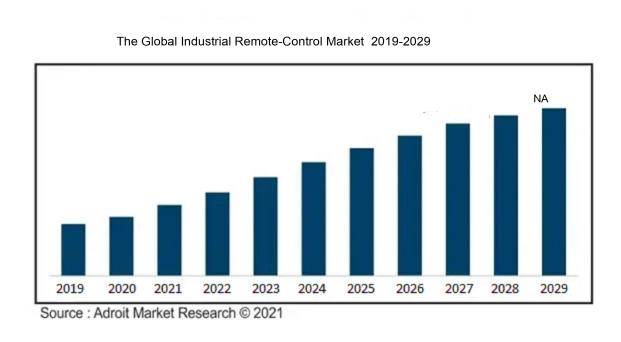Market analysis and forecast-
The global industrial remote-control market is estimated to reach a market value of USD XX billion dollars for 2029 with an estimated CAGR of XX% during the forecast period.

The primary catalyst for this progress is the escalating requirement for mechanization and remote-commanded activities across diverse sectors. Manufacturing, mining, oil and gas, as well as ports and maritime sectors, are embracing sophisticated industrial remote-control systems to amplify operational effectiveness and ensure worker well-being.
Industrial Remote-Control Market Scope :
| Metrics | Details |
| Base Year | 2023 |
| Historic Data | 2018-2022 |
| Forecast Period | 2024-2029 |
| Study Period | 2018-2029 |
| Forecast Unit | Value (USD) |
| Revenue forecast in 2029 | NA |
| Growth Rate | CAGR of NA during 2019-2029 |
| Segment Covered | by Type, by Application , by region, |
| Regions Covered | North America, Europe, Asia Pacific, South America, Middle East and Africa |
| Key Players Profiled | Hetronic, Inc., ITOWA, Autec Srl, Allgon, IMET s.r.l, NBB Controls + Components GmbH, Magnetek, Cavotec, Danfoss, ABITRON Germany GmbH, Hysea Industrial Communications. |
Market Definition-
The global market for industrial remote control pertains to the sector that is committed to the advancement, production, and implementation of specialized devices and systems that empower distant operation and regulation of industrial machinery, equipment, and procedures.
These solutions for remote control enable operators to manipulate, monitor, and manage industrial procedures and machinery from afar, frequently in difficult or dangerous environments. This market encompasses a broad range of technologies for remote control, including wireless and wired systems, specifically designed to cater to diverse industries such as manufacturing, mining, oil and gas, ports, maritime, and more. Industrial remote-control systems are crucial for enhancing operational efficiency, improving worker safety, and ensuring accuracy in tasks where human intervention may be limited or unsafe.
Modern features like user-friendly interfaces, secure communication protocols, and interaction with new technologies like the Internet of Things (IoT) energy are typically included in these systems. The global market for industrial remote control plays a vital role in propelling automation across industries, minimizing human exposure to risks, and optimizing industrial processes for enhanced productivity and safety.
Key market insights-

Insights on Type
Wireless Remote-Control Segment Holds the Largest Share
With the progressions in wireless technology, the utilization of wireless remote-control systems has become increasingly prevalent. These systems provide a high degree of flexibility and mobility, enabling operators to effortlessly manipulate equipment from a distance. This not only enhances overall productivity but also ensures the safety of the operators. On the other hand, corded remote control systems, although considered traditional, still hold relevance in certain industries. They offer stable and dependable connections, making them particularly suitable for crucial operations where signal reliability is of utmost importance.
Insights on Application
The Industrial Segment Holds the Largest Share
The industrial realm stands as a significant consumer of remote manipulation systems. Sectors like production and building deploy machinery operated from a distance to achieve accuracy and effectiveness in various procedures.
In the domain of mining, remote-controlled equipment finds utility in perilous settings, bolstering the safety of workers while boosting productivity in the processes of extraction and transportation. The sector of oil and gas heavily relies on remote control systems for exploration and extraction purposes. These systems find application in drilling, maintaining pipelines, and conducting offshore operations, thereby ensuring efficiency and safety even in challenging environments.
In the realm of ports and maritime activities, the utilization of remote-controlled cranes, ships, and maritime equipment assumes paramount importance for streamlined port operations. These remote-control systems facilitate precise handling of cargo, mitigating the risk of accidents and augmenting overall port productivity.
Insights on Region
North America has a substantial share of the market.
In North America, the market is led by well-established industrial sectors and a strong emphasis on automation. The region's advanced technological infrastructure and strict safety regulations drive the adoption of remote-control systems in industries. The presence of key players in the market and continuous innovations further contribute to North America's dominance.
South America, on the other hand, experiences steady growth in the remote-control market, primarily propelled by the mining and oil and gas sectors. However, political instability in certain countries can impede market expansion. Despite these challenges, the demand for remote control systems remains high in resource-intensive industries.
Europe showcases significant demand for remote control systems in industries, particularly in the manufacturing and maritime sectors. Stringent safety standards and regulations in the region compel industries to adopt remote control technologies. Europe's focus on enhancing operational efficiency and ensuring worker safety continues to drive market growth.
In the Asia-Pacific region, there is robust growth in the market, fueled by rapid industrialization and infrastructure developments. The thriving manufacturing sector and increased automation contribute to the region's ened demand for remote control systems. The future of the market is significantly shaped by the developing economies in the Asia-Pacific region.
The needs of the oil and gas sector are the primary driver of the progressive increase in the use of remote-control systems in industry throughout the Middle East and Africa. The rise of the market in this region is mostly attributed to investments in offshore exploration and exploitation.
Key Company Players
Several important factors are driving the huge expansion of the global industrial remote-control market. These include the rising trend of industrial automation, a strong emphasis on ensuring worker safety, advancements in wireless communication technology, and the increasing demand for machinery that can be operated remotely in sectors such as manufacturing, mining, oil and gas, and maritime operations.
The major company players in the market are- Hetronic, Inc., ITOWA, Autec Srl, Allgon, IMET s.r.l, NBB Controls + Components GmbH, Magnetek, Cavotec, Danfoss, ABITRON Germany GmbH, Hysea Industrial Communications.
COVID- 19 Analysis and Impact
The outbreak of the COVID-19 pandemic caused significant disturbances in the global supply chain and resulted in a deceleration of manufacturing operations on a worldwide scale. Nonetheless, this crisis expedited the acceptance of automation and technologies that can be controlled from a distance. Various sectors, such as healthcare, logistics, and manufacturing, wholeheartedly embraced remote control systems in order to reduce human interaction and guarantee the uninterrupted flow of business operations. Although the initial stage posed certain difficulties, industries quickly rebounded as they acknowledged the critical role of remote-controlled procedures in maintaining operational fortitude.
Latest Trends and Innovations
Industrial remote-control systems are experiencing a growing integration with Internet of Things (IoT) technologies. This assimilation enables the ability to monitor in real time, predict maintenance requirements, and analyze data, thereby enhancing the efficiency of operations.
To bolster security, manufacturers are placing emphasis on enhancing the features of remote-control systems. This includes implementing encrypted communication, multi-factor authentication, and biometric recognition to prevent unauthorized access and ensure the integrity of data.
In addition, companies are providing customized remote-control solutions that are tailored to meet the specific needs of various industries. Furthermore, these solutions are accompanied by user-friendly interfaces and ergonomically designed controls, which significantly improve the experience and efficiency of operators.
Significant Growth Factors
The proliferation of automation in various sectors is gaining momentum. This surge in automation is primarily motivated by the pursuit of efficiency and precision, leading to an increased need for industrial remote-control systems. Automation is vital in protecting worker safety because it reduces human interaction in dangerous work conditions.
The mining sector is expanding significantly, especially in emerging nations, which is driving up demand for remote-controlled mining equipment. By employing such machinery, mining operations can be executed with enhanced safety measures and gain access to locations that were once inaccessible.
The continuous evolution of wireless communication technologies, sensors, and batteries is driving technological advancements in industrial remote-control systems. These advancements pave the way for improved signal range, reduced response time, and extended battery life, ultimately contributing to the growth of the market.
Restraining Factors
Complying with strict regulations and standards regarding safety in industries and wireless communication presents difficulties for companies operating in the market. It is of utmost importance to ensure adherence to these regulations as it can have significant effects on the development of products and entry into the market.
The upfront expenses associated with implementing advanced remote-control systems for industrial purposes can be substantial. Small and medium-sized enterprises (SMEs) may encounter obstacles when trying to invest in these technologies, thereby limiting their presence in specific sectors.
Key Segments of the Global Industrial Remote-Control Market
Type Overview
• Wireless Remote Control
• Corded Remote Control
Application Overview
• Industrial
• Mining
• Oil and Gas
• Ports and Maritime
Regional Overview
North America
• U.S.
• Canada
• Mexico
Europe
• Germany
• France
• U.K.
• Spain
• Italy
• Russia
• Rest of Europe
Asia Pacific
• China
• Japan
• India
• South Korea
• ASEAN
• Australia
• Rest of Asia Pacific
Middle East & Africa
• Saudi Arabia
• UAE
• South Africa
• Egypt
• Ghana
• Rest of MEA
Latin America
• Brazil
• Argentina
• Colombia
• Rest of Latin America

